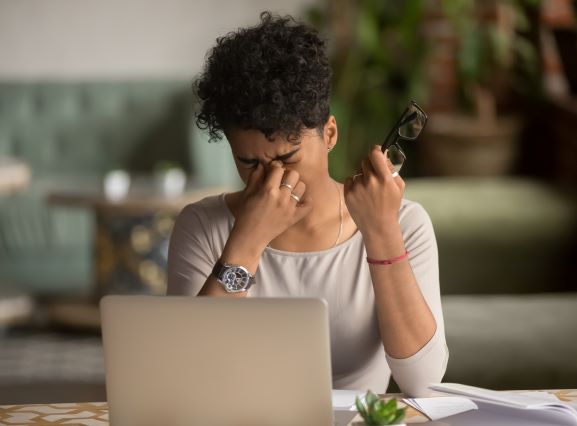Combating Eye Strain: The 20-20-20 Rule
 Publié le 5 May 2020
Publié le 5 May 2020
Many of us look at screens at all times of the day. You’re looking at one right now. Whether it’s computers, smartphones, or TVs, we use screens to work, communicate, play and relax. Our eyes are like any other part of our bodies, and can be strained or injured with overexertion. The time we spend staring at screens can contribute to eye strain. It’s important that we recognize this possibility and do what we can to ease the pressure on our eyes. The 20-20-20 rule can be an effective method for combating eye strain and giving ourselves a break.
The Rise of Screen Time
Technology has become an almost inextricable component of our professional and personal lives. Studies have found that the average adult will spend more than half of their day interacting with screens, something that would have seemed unimaginable just a couple decades ago. For many, being on a computer is how we do our jobs, so it can be very difficult to reduce the amount of time we spend on our various screens. While our computers, phones and TVs are all incredibly useful tools, there is a drawback to the amount of time we spend with our devices.
Our eyes can be greatly affected by our screens. It is a source of bright unnatural light that changes rapidly, causes our eyes to constantly move and readjust as we work and absorb information. Just think about how often what’s on your screen changes when you are searching for a specific article online, or playing a video game during leisure time. Every single movement is work for our eyes, and this effect is compounded over the course of the day.
One of the simplest methods- in theory – for combating eye strain is to limit that amount of time we spend with our screens. Many popular apps now come with the ability to tell us how much time we spent using them during the day, week or month. There have also been an explosion of other apps and programs designed to block access to our screens and force us to limit our screen time.
Working From Home is Hard on the Eyes
With the number of people working from home and telecommuting right now, professional time and personal time have started to blur together for many. Using the same computer for work and also having a video chat with our families makes it hard to keep track of how much screen time we have had for the day.
People already experience enough difficulty when it comes to maintaining a proper work-life balance, and the blurring of professional and personal boundaries is a real problem. If the laptop we were working on all day is sitting next to us in the evening when an email notification pops up, it’s hard not to turn it back on and get back to work. This returns us to work mode and demands even more of our mental stamina and physical health, including our eyes.
Computer Vision Syndrome
There’s even an official name of the eye strain that comes from too much screen usage: Computer Vision Syndrome. Symptoms include:
- Headaches
- Eye irritation
- Blurred vision
- Double vision
- Excessive tearing and blinking
This is a real condition that should be taken seriously. Maintaining healthy vision is important to our lives and overall health. There are steps we can all take to ease the strain on our eyes, such as putting our computers at the correct ergonomic distance, adjusting the brightness to a comfortable level, wearing glasses with the proper prescription, and using the 20-20-20 rule.
What is the 20-20-20 Rule?
The 20-20-20 rule is a way to mitigate eye strain and hopefully avoid its negative effects. Promoted by the Canadian Association of Optometrists and the American Optometric Association, it is a very simple process:
- After staring at a screen for 20 minutes
- Stare at something else 20 feet away
- For a total of 20 seconds
20 minutes, 20 feet, 20 seconds.
The idea behind the rule is that it purportedly takes a full 20 seconds for our eyes to relax. By forcing our vision to focus onto a distant object for that length of time, it relaxes our eyes after spending minutes or hours interacting with screens that are very close to our faces. Think of it like finally putting your arms down after holding up a heavy box.
After this short break, your eyes will be better rested and ready to resume work on the computer. We already know that taking breaks is very important while working from home, and incorporating the 20-20-20 rule is an effective way that our breaks can help us feel as refreshed and recharged as possible.
Things You Can Stare At That Are 20 Feet Away
Does staring 20 feet into the distance sound boring to you? It doesn’t have to be! You can apply the 20-20-20 rule for combating eye strain and be entertained at the same time. Here are a few fun things you can stare at that are 20 feet away:
- A fun picture from when we could go out and do things
- A jar of sourdough starter that could probably use another feeding
- A box of wine waiting for the second work ends
- A neighbour waging war on the squirrels that keep getting into the bird feeder
- A calendar so you remember that thing you were supposed to do
- A note pinned underneath your calendar to remind you that thing was canceled
- A scruffy dog who deserves a belly rub
A Simple Way to Maintain Our Well-Being
As we adjust to working-from-home, we must remember to do what we can to maintain our health and well-being. With increased screen time and difficulty separating work from home life, it is possible we are putting our eyes under more strain than ever before. Acting now and forming good habits is a great way to prevent the worst effects of eye strain before they begin.
The 20-20-20 rule is a simple and effective way to give your eyes a well deserved break. Combating eye strain with the 20-20-20 rule literally just takes seconds, and it is possible that we will prevent ourselves from experiencing physical pain and discomfort that will affect both our professional and personal lives.







